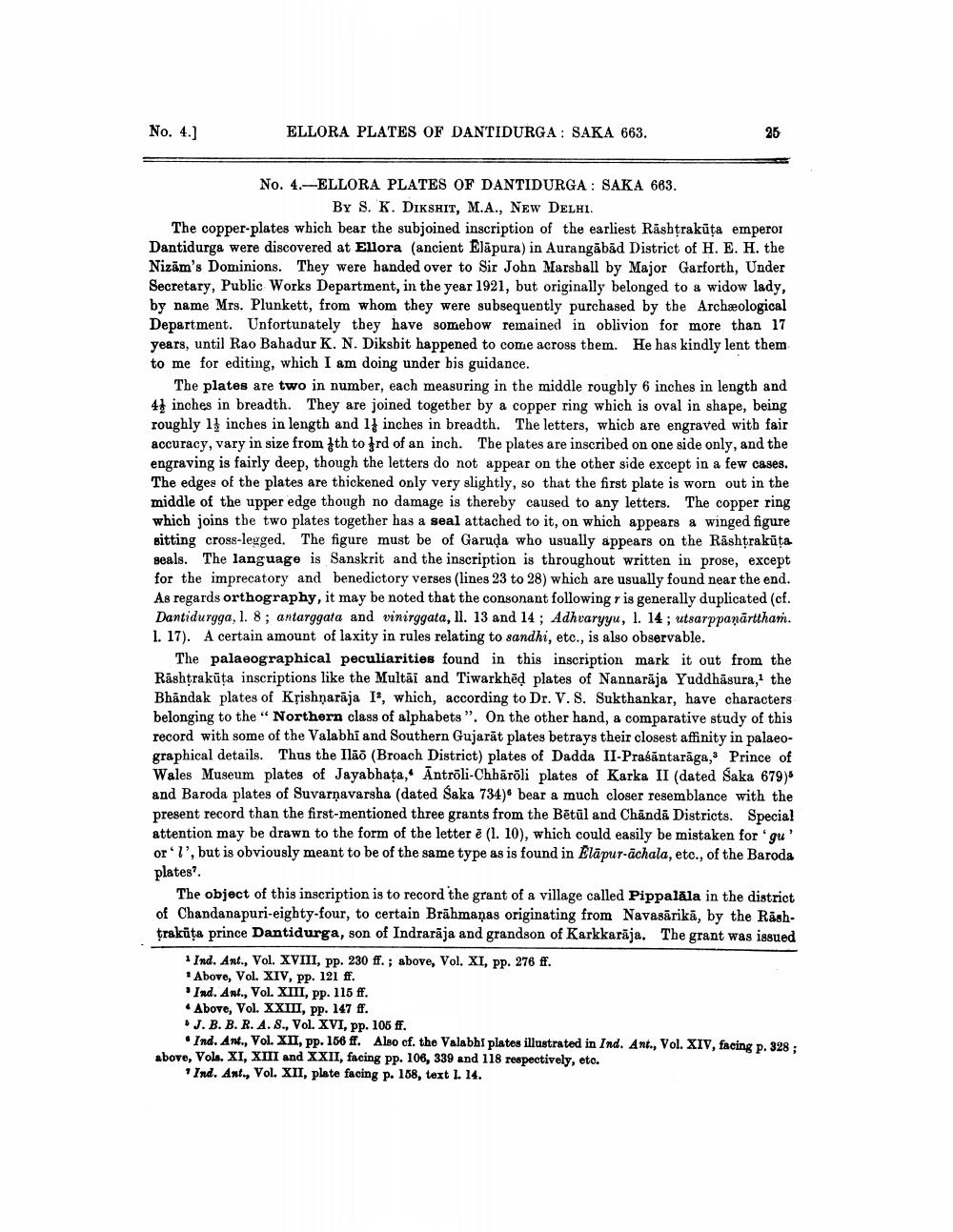________________
No. 4.]
ELLORA PLATES OF DANTIDURGA: SAKA 663.
No. 4.-ELLORA PLATES OF DANTIDURGA : SAKA 663.
By S. K. DIKSHIT, M.A., NEW DELHI. The copper-plates which bear the subjoined inscription of the earliest Rashtrakūta emperor Dantidurga were discovered at Ellora (ancient Elāpura) in Aurangabad District of H. E. H. the Nizam's Dominions. They were handed over to Sir John Marshall by Major Garforth, Under Secretary, Public Works Department, in the year 1921, but originally belonged to a widow lady, by name Mrs. Plunkett, from whom they were subsequently purchased by the Archaeological Department. Unfortunately they have somebow remained in oblivion for more than 17 years, until Rao Bahadur K. N. Diksbit happened to come across them. He has kindly lent them to me for editing, which I am doing under bis guidance.
The plates are two in number, each measuring in the middle rougbly 6 inches in length and 41 inches in breadth. They are joined together by a copper ring which is oval in shape, being roughly 1} inches in length and 14 inches in breadth. The letters, whicb are engraved with fair accuracy, vary in size from 4th to frd of an inch. The plates are inscribed on one side only, and the engraving is fairly deep, though the letters do not appear on the other side except in a few cases. The edges of the plates are thickened only very slightly, so that the first plate is worn out in the middle of the upper edge though no damage is thereby caused to any letters. The copper ring which joins the two plates together has a seal attached to it, on which appears a winged figure sitting cross-legged. The figure must be of Garuda who usually appears on the Rashtrakūta. seals. The language is Sanskrit and the inscription is throughout written in prose, except for the imprecatory and benedictory verses (lines 23 to 28) which are usually found near the end. As regards orthography, it may be noted that the consonant following r is generally duplicated (cf. Dantidurgga, 1. 8; antarggata and vinirggata, ll. 13 and 14 ; Adhuaryyu, 1. 14 ; utsarppaņārttham. 1. 17). A certain amount of laxity in rules relating to sandhi, etc., is also observable.
The palaeographical peculiarities found in this inscription mark it out from the Rashtrakūta inscriptions like the Multāi and Tiwarkhēd plates of Nannaräja Yuddhăsura, the Bhandak plates of Krishnarāja I", which, according to Dr. V. S. Sukthankar, have characters belonging to the Northern class of alphabets". On the other hand, a comparative study of this record with some of the Valabhi and Southern Gujarāt plates betrays their closest affinity in palaeographical details. Thus the Ilão (Broach District) plates of Dadda II-Praśāntarāga, Prince of Wales Museum plates of Jayabhata, Antrõli-Chhäröli plates of Karka II (dated Saka 679) and Baroda plates of Suvarnavarsha (dated Saka 734) bear a much closer resemblance with the present record than the first-mentioned three grants from the Bētül and Chända Districts. Special attention may be drawn to the form of the letter ē (1. 10), which could easily be mistaken for gu' or 'T', but is obviously meant to be of the same type as is found in Elāpur-āchala, etc., of the Baroda plates?
The object of this inscription is to record the grant of a village called Pippaläla in the district of Chandanapuri-eighty-four, to certain Brāhmaṇas originating from Navasärikā, by the Rashtrakūta prince Dantidurga, son of Indrarāja and grandson of Karkkarāja. The grant was issued
1 Ind. Ant., Vol. XVIII, pp. 230 ff.; above, Vol. XI, pp. 276 ff. * Above, Vol. XIV, Pp. 121 ff.
Ind. Ant., Vol. XIII, pp. 115 ff. . Above, Vol. XXIII, pp. 147 ff.
J. B. B. R. A.S., Vol. XVI, pp. 106 ff.
• Ind. Ant., Vol. XII, pp. 156 ff. Also of the Valabhi plates illustrated in Ind. Ant., Vol. XIV, facing p. 328 : abovo, Vols. XI, XIII and XXII, facing pp. 106, 339 and 118 respectively, eto.
* Ind. Ant., Vol. XII, plate facing p. 158, text I. 14.




